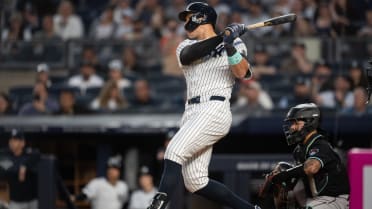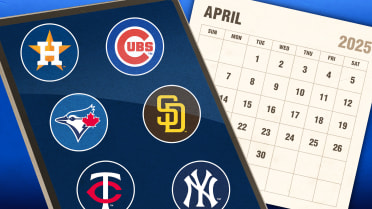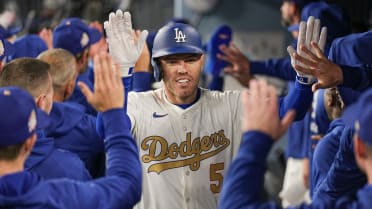GLENDALE, Ariz. -- Having a team compete annually in the big leagues or having a continually strong farm system -- it’s typically an either/or situation. Just look at teams like the Royals and Cubs as examples of organizations that had top systems then won a World Series. Generally, the expense of going for it all is the drying out of the pipeline.
One big exception to the rule has been the Dodgers. They’ve made the postseason six years in a row, playing in the World Series in the last two. At the same time, they have the only farm system to be ranked in the top 10 by MLB Pipeline in each of the nine preseason and midseason rankings since the start of 2015, including coming in at No. 7 this spring.
“It starts with a tremendous group of scouts who continually gives us high quality players,” Dodgers farm director Brandon Gomes said. “They’re seeing and identifying traits they think our player development system can help with. Scouts are doing a great job. We have a nice working relationship with them, where it’s a collaborative unit. We take a lot of pride in our coordinators and coaching staff, that they can get guys better, using all of our resources to get the most out of every single guy with an individualistic approach.”
While the Dodgers have gotten large contributions lately from first-round picks like Walker Buehler and Corey Seager, or an over-slot signing, like 2013 fourth-rounder Cody Bellinger, it should be noted the organization has been finding these big league regulars while consistently picking in the lower half of the first round. The last time the Dodgers picked in the top half of the first round was when they took Ethan Martin No. 15 overall in 2008 and they haven’t had a top 10 pick since grabbing Clayton Kershaw at No. 7 back in 2006.
“I hope we’re not doing that any time soon, either,” Gomes said about picking that high. “The scouts put in a ton of time, digging into things like makeup and identifying things that will impact Major League rosters and putting it in the hands of our coaches at that point to make that happen.”
It's not just the early-round picks that have led to this continual development of big league talent, though 2016 first-rounders Gavin Lux and Will Smith are both among the team's top 10 prospects. The Dodgers have done a fantastic job of finding guys in later rounds, or for lesser amounts on the international market, to keep that pipeline flowing.
“You get guys who are talented, get those guys better, then there are the lower-round picks, getting those guys to maximize their potential,” Gomes said. “You get the Tony Gonsolins (a ninth-round pick in 2016 who signed for $2,500) of the world, who kind of come out of nowhere. That goes back to the scouting.”
That makes coming to camp every spring fun for guys like Gomes. The next wave of talent preparing to help out, either in Los Angeles or perhaps as trade fodder to bring in established big leaguers, is starting to amass in the upper levels of the system. That naturally creates some competition, with players here inherently knowing that if they don’t get the job done, someone behind them likely can. The best thing for the player development staff is that happens organically, not by any kind of culture they try to design during Spring Training.
“That’s a natural feeling for guys,” Gomes said. “We really try to promote that you’re just playing against yourself. The better you can make yourself, if you’re performing well, you don’t have anything else to worry about. Not playing the guys against each other as much as how good can you be on a daily basis and can you get better every single day. At the end of the season, you’ll be in a pretty good position.”
Camp standout
Outfielder DJ Peters, No. 11 on the Dodgers’ Top 30, puts up big numbers. That includes home runs, extra-base hits and, yes, strikeouts. He won the California League MVP in 2017, his first full season, and finished second in the organization with 27 homers. He also struck out 189 times. A year ago, he topped the system and all Double-A hitters with 29 homers while pacing the Texas League in extra-base hits and total bases while helping Tulsa win a championship. With that output came 192 K’s and a slight drop in walk rate.
He was constantly tinkering with his swing and never fully felt comfortable, with the positive being he still was a productive power hitter. He came to camp determined to stick to the changes he made before coming to camp.
“He still had a great year last year and he was messing with a whole bunch of different swings and stances,” Gomes said. “He worked really hard this offseason so getting DJ out and getting going and seeing what these new changes will bring about is really exciting.”
There’s always going to be swing and miss to his game, given his long-limbed, 6-foot-4 frame. But he’s worked to simplify his swing and cut down on the moving parts that led to floppiness in his swing at times last year, and it’s been so far, so good.
“He looks really good right now, working with our hitting coaches,” Gomes said. “Pretty much all offseason, he was getting in there and trying to cover up some of the holes that caused the high punchout rate from last year. To his credit, this guy will work and work and buy into whatever we ask him to do. As he has always done, he has gone full go on this swing overhaul. We’re excited to see DJ get four at-bats a day and start to get a good rhythm and see what this new swing is going to look like.”
Jonathan Mayo is a reporter for MLBPipeline.com. Follow him on Facebook and @JonathanMayo, and listen to him on the weekly MLB Pipeline Podcast.




